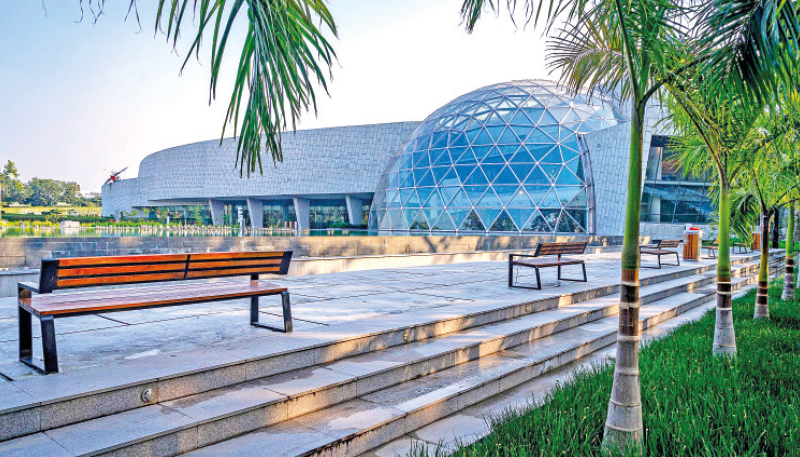Introduction
In the dynamic landscape of architecture, facade design stands as a crucial element that not only defines the aesthetic appeal of a building but also enhances its functional efficiency. In Bangladesh, a country rich in cultural heritage and rapid urban development, facade design plays a pivotal role in bridging traditional architectural styles with contemporary needs. This article explores the significance, trends, and innovations in facade design in Bangladesh, highlighting how designers are creating visually striking and sustainable buildings.
The Significance of Facade Design
Aesthetic Appeal
The facade is the face of a building, creating the first impression for onlookers. In Bangladesh, architects often draw inspiration from traditional motifs and patterns, integrating them into modern designs. This fusion results in unique facades that resonate with cultural identity while catering to contemporary tastes.
Environmental Performance
Bangladesh’s tropical climate necessitates facades that enhance energy efficiency. Proper facade design can significantly reduce the need for artificial cooling and lighting, promoting sustainability. Techniques such as shading devices, double-skin facades, and the use of sustainable materials are increasingly popular.
Social and Cultural Impact
Facade design in Bangladesh often reflects the socio-cultural context. Elements such as jali (perforated screens) and verandas are not only aesthetic choices but also serve functional purposes like ventilation and privacy, rooted in traditional architecture.”Glass has the ability to open up a space, unlike solid concrete walls. And this is something the indoor desk-based corporate world needs- an ample amount of light to get the maximum output from the employees,” he said.
In a 2009 journal titled, ‘Daylight for energy savings and psycho-physiological well-being in sustainable built environments,’ the author Sergio Altomonte emphasised on how natural daylight is important in a workplace. According to the paper, daylight can positively influence the health of office personnel, improving efficiency, reducing unnecessary sick leaves, and resulting in greater benefits for enhanced productivity. If carefully designed, a daylight strategy can also bring tangible energy savings, as long as it minimizes energy use for artificial lighting and prevents glare and other visual discomforts (such as contrast, adaptation problems, and internal reflections). “In Bangladesh, we have a humid, hot, and windy atmosphere,” said architect Jubayer Shahadat, adding “that is why we see this glass façade trend in corporate areas, where a pleasantly cool temperature is necessary inside the office for maximum employee output, heat insulation is hence important.”
Why glass?
glass is becoming increasingly popular; people can now afford high-quality glass panels that enhance the city’s glamour, and the market offers better technology, making glass safer and sturdier. Moreover, in Bangladesh, a tropical country with abundant direct sunlight, architects favor double-glazed low-e glass (low emissivity) for its functionality beyond just design aesthetics. Ehsan Khan, the designer of the 40-story ‘Shanta Pinnacle’, which will be the tallest building in the country, stated, “Glass sheets are now used with functionality in mind, not just as design elements.”
Current Trends in Facade Design
Integration of Traditional Elements
Modern Bangladeshi architecture frequently incorporates traditional elements like terracotta, bamboo, and brick. These materials are not only locally sourced and sustainable but also evoke a sense of cultural continuity. For instance, terracotta screens provide natural cooling and add intricate patterns to the building’s exterior.
Smart and Adaptive Facades
With technological advancements, smart facades that adapt to environmental conditions are gaining traction. These facades can regulate temperature, light, and air flow, enhancing indoor comfort and reducing energy consumption. Such innovations are essential in the context of Bangladesh’s climate and energy challenges.
Use of Sustainable Materials
Sustainability is at the forefront of facade design in Bangladesh. Architects are increasingly opting for recycled and eco-friendly materials. Green facades, incorporating vertical gardens, not only improve air quality but also add a refreshing aesthetic to urban spaces.
Contemporary Aesthetics
While tradition holds strong, contemporary designs featuring sleek lines, glass, and steel are also prevalent. These modern facades often represent the aspirations of a growing economy and the global outlook of Bangladeshi urban centers.
Challenges and Solutions
Climate Adaptation
The hot and humid climate of Bangladesh poses a significant challenge for facade design. Solutions include the use of passive cooling techniques, reflective coatings, and high-performance glazing to minimize heat gain and enhance thermal comfort.
Urban Density
High population density in urban areas demands innovative facade solutions to maximize space while ensuring privacy and natural light. Strategies like vertical gardens, cantilevered balconies, and modular designs address these challenges effectively.
Cost Constraints
Economic factors often limit the scope of facade design. However, cost-effective solutions such as the use of local materials and prefabricated components can reduce expenses while maintaining quality and aesthetic appeal.
Growing popularity as building material
Glass has now emerged as an intelligent building material, thanks to advancements in the manufacturing technology of curtain glass. These glass pieces are meticulously designed and produced in industrial settings, then delivered to construction sites as prefabricated materials. Globally recognized for its utility, glass has become a popular building material in Bangladesh as well.
“Apartment windows typically use 5 to 5.5 mm mercury or reflective glasses, while commercial spaces opt for 10-12 mm glasses. Government projects prefer clear glasses, and 10 mm tempered glasses are used for partitions,” stated Akhtarul Islam, Dhaka area manager of Nasir Glass Industries. For curtain walls, double glazed low-e glasses, primarily 10 mm and tempered, are often used. These double glazed glasses, which sometimes incorporate two colored glasses with air or argon gas insulation in between, help maintain building temperature efficiently.
Adding argon gas to double-pane windows enhances thermal insulation due to its higher density compared to air. When combined with a special low-e glass coating, argon gas windows align the window temperature more closely with room temperature.
The glass industry in Bangladesh is witnessing an annual growth of 8-10%, with local companies supplying 90% of the domestic demand. According to recent reports, the industry is valued at approximately Tk1,500-2,000 crore. The country’s annual demand for glass stands at 25 crore square feet, while the production capacity of both private and public manufacturers reaches 32 crore square feet.
Iconic Facade Designs in Bangladesh
Bangabandhu Military Museum
Welcome to the Bangabandhu Military Museum, where history comes alive. Our meticulously curated exhibits showcase a vast array of artifacts, weaponry, and interactive displays, offering a vivid glimpse into historical battlefields. Experience the sights and sounds of bygone eras through our immersive exhibits that transport you back in time.
Whether you’re a history enthusiast, a student eager to learn, or someone wishing to honor those who served, our museum provides a deeply engaging experience. Join us in paying tribute to the brave men and women who dedicated their lives to defending our nation, preserving peace, and upholding the values we cherish. Our thought-provoking exhibits and interactive displays aim to create an educational and emotional journey, leaving a lasting impact on all who visit.
Dtech Landmark projects
Bangladesh Military Museum is a military museum of Bangladesh. This is controlled by the Bangladesh Army, the museum is located at Bijoy Sarani of the capital Dhaka. The museum has a collection of Bangladesh, ‘s military history, heritage, success stories, and various weapons and ammunition.
Location: Bijoy Sharani, Dhaka, Bangladesh.
Project By: Bangladesh Army (MES)
Consultant: Nakshabid Architect
Architect : Bayejid M.Khondoker Ali Imam
Main Contractor: Spectra Group
Facade Contractors: Dtech Corp.Ltd.
Scope of works:
-39m dia,19.5m height geodesic glass dome (CST,USA)
-19m dia art glass dome (Zamil, KSA)
-Exterior & Interior glazing works
Conclusion
Facade design in Bangladesh is a testament to the country’s ability to balance tradition with modernity. As architects and designers continue to innovate, the facades of Bangladeshi buildings will not only contribute to the aesthetic and cultural fabric of the nation but also promote sustainability and resilience in the face of environmental challenges. The future of facade design in Bangladesh looks promising, with a blend of heritage and innovation leading the way.Bangladesh, with its rich historical background and cultural diversity, has always been a land where tradition meets modernity. This is especially evident in the country’s architecture. Traditional elements are not just relics of the past but living components that coexist with contemporary design principles. The facades of buildings in Bangladesh often reflect this harmonious blend. For instance, traditional terracotta bricks, jali (lattice) work, and ornate carvings are frequently incorporated into modern structures, creating a unique architectural language that speaks to both the past and the present.Architects in Bangladesh are adept at weaving traditional motifs and materials into modern designs. This practice is not only about aesthetic appeal but also about functionality. Traditional design elements, such as deep overhangs, shaded verandas, and courtyards, are climate-responsive features that help in natural cooling and ventilation, addressing the tropical climate of the region. By integrating these features into contemporary facades, architects are able to create buildings that are both beautiful and environmentally efficient.


Leave a Reply